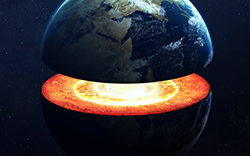Magnetic attraction helps explain the motion under the ocean
When dating and tracking the evolution of oceanic crust, plate tectonics research usually relies on a combination of knowledge about periods when the polarity of the planet's geomagnetic field was reversed, alongside magnetic anomalies. After volcanic activity, the ensuing magma cools at the mid-ocean ridge and the minerals contained in the newly forming rock magnetize and align with the direction of planet's magnetic field. These magnetic traces can therefore serve as a date stamp for the crust. However, the planet’s geomagnetic field polarity has actually stayed stable in the past for periods lasting for as long as tens of millions of years (Myr), a timeframe known as a superchron. The ocean floor for these periods, lacking prominent magnetic anomalies, thus presents a challenge when it comes to the creation of accurate plate kinematic models. Interpreting magnetic wiggles to understand the past The EU supported GEOPLATE project set out to examine the progression of plate motion during the period known as the Cretaceous normal superchron (CNS, between ~121 and 83 Myr ago). By analyzing oceanic records, the project investigated the geomagnetic field’s behaviour to present the first plate kinematic models for the CNS. The project was able to do so by applying an innovative approach which reconstructed plate movement from evidence left by past fluctuations in the strength of the geomagnetic field. These fluctuations left magnetic traces, described as tiny ‘wiggles’, which were located using magnetic sensing equipment. The project results have expanded understanding of a number of continental and oceanic phenomena related to the interaction between surface tectonic plates, mantle convection, and geomagnetic field processes, during the long CNS period. For example, it helps explain some of the contributing factors for phenomena such as sea levels which are considered to have been abnormally high during the mid-Cretaceous. Techniques which could help locate future natural resources These new kinematic models which GEOPLATE accomplished, contribute to a deeper appreciation of how rates of crustal production and sea floor spreading (resulting from new oceanic crust created by volcanic activity) influence continental drift and so could help explain the plate motion process which resulted in the breakup of the ancient supercontinent Gondwana. Analyzing the marine magnetic records has also resulted in age models that have produced some noteworthy results. For example, GEOPLATE techniques indicated that the oldest oceanic crust in the world is located in the eastern Mediterranean Sea and that it is possibly almost 340 million years-old. However, as well as deepening our understanding of the past the project also offers tools applicable to the present. We know that past tectonic motion has helped shape the development of the lithosphere, biosphere, hydrosphere, cryosphere, and global climate with important consequences. For instance, by providing insights into the formation of continental marginal basins, GEOPLATE could help researchers locate prospective regions for new mineral and hydrocarbon reservoirs.
Countries
Israel



